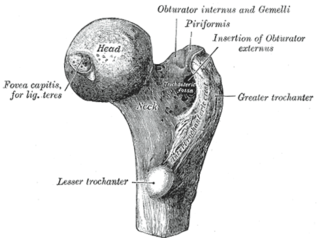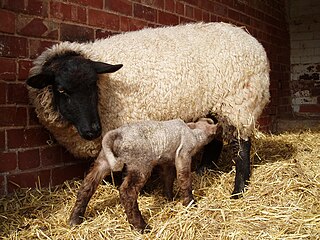
A calf is a young domestic cow or bull. Calves are reared to become adult cattle or are slaughtered for their meat, called veal, and hide.

In biology, an organ is a collection of tissues joined in a structural unit to serve a common function. In the hierarchy of life, an organ lies between tissue and an organ system. Tissues are formed from same type cells to act together in a function. Tissues of different types combine to form an organ which has a specific function. The intestinal wall for example is formed by epithelial tissue, and smooth muscle tissue. Two or more organs working together in the execution of a specific body function form an organ system, also called a biological system or body system.

Canopic jars were used by the ancient Egyptians during the mummification process to store and preserve the viscera of their owner for the afterlife. They were commonly either carved from limestone or were made of pottery. These jars were used by the ancient Egyptians from the time of the Old Kingdom until the time of the Late Period or the Ptolemaic Period, by which time the viscera were simply wrapped and placed with the body. The viscera were not kept in a single canopic jar: each jar was reserved for specific organs. The term canopic reflects the mistaken association by early Egyptologists with the Greek legend of Canopus – the boat captain of Menelaus on the voyage to Troy – "who was buried at Canopus in the Delta where he was worshipped in the form of a jar". In alternative versions, the name derives from the location Canopus in the western Nile Delta near Alexandria, where human-headed jars were worshipped as personifications of the god Osiris.
In medicine, prolapse is a condition in which organs fall down or slip out of place. It is used for organs protruding through the vagina, rectum, or for the misalignment of the valves of the heart. A spinal disc herniation is also sometimes called "disc prolapse". Prolapse means "to fall out of place", from the Latin prolabi meaning "to fall out".

In mathematics, and particularly topology, a fiber bundle is a space that is locally a product space, but globally may have a different topological structure. Specifically, the similarity between a space and a product space is defined using a continuous surjective map, , that in small regions of behaves just like a projection from corresponding regions of to . The map , called the projection or submersion of the bundle, is regarded as part of the structure of the bundle. The space is known as the total space of the fiber bundle, as the base space, and the fiber.

Legg–Calvé–Perthes disease (LCPD), is a childhood hip disorder initiated by a disruption of blood flow to the head of the femur. Due to the lack of blood flow, the bone dies and stops growing. Over time, healing occurs by new blood vessels infiltrating the dead bone and removing the necrotic bone which leads to a loss of bone mass and a weakening of the femoral head.

Situs inversus is a congenital condition in which the major visceral organs are reversed or mirrored from their normal positions. The normal arrangement of internal organs is known as situs solitus. Although cardiac problems are more common, many people with situs inversus have no medical symptoms or complications resulting from the condition, and until the advent of modern medicine, it was usually undiagnosed.
In healthcare, a differential diagnosis is a method of analysis of a patient's history and physical examination to arrive at the correct diagnosis. It involves distinguishing a particular disease or condition from others that present with similar clinical features. Differential diagnostic procedures are used by clinicians to diagnose the specific disease in a patient, or, at least, to consider any imminently life-threatening conditions. Often, each individual option of a possible disease is called a differential diagnosis.

Nelson Frazier Jr. was an American professional wrestler, best known for his appearances with the World Wrestling Federation/World Wrestling Entertainment (WWF/WWE) in the 1990s and 2000s under the ring names Mabel, King Mabel, Viscera, and Big Daddy V. A former WWF World Tag Team Champion and WWF Hardcore Champion, he won the 1995 King of the Ring tournament and consequently challenged for the WWF Championship in the main event of that year's SummerSlam.

A limp is a type of asymmetric abnormality of the gait. Limping may be caused by pain, weakness, neuromuscular imbalance, or a skeletal deformity. The most common underlying cause of a painful limp is physical trauma; however, in the absence of trauma, other serious causes, such as septic arthritis or slipped capital femoral epiphysis, may be present. The diagnostic approach involves ruling out potentially serious causes via the use of X-rays, blood tests, and sometimes joint aspiration. Initial treatment involves pain management. A limp is the presenting problem in about 4% of children who visit hospital emergency departments.

Congenital diaphragmatic hernia (CDH) is a birth defect of the diaphragm. The most common type of CDH is a Bochdalek hernia; other types include Morgagni hernia, diaphragm eventration and central tendon defects of the diaphragm. Malformation of the diaphragm allows the abdominal organs to push into the chest cavity, hindering proper lung formation.

Otis Campbell is the fictional "town drunk" in Mayberry on the American TV sitcom The Andy Griffith Show. Otis was played by Hal Smith and made frequent appearances on the show from 1960 to 1967 but stopped appearing toward the end of the series because of concerns raised by the sponsors over the portrayal of excessive drinking.

A femoral head ostectomy is a surgical operation to remove the head and neck from the femur. It is performed to alleviate pain, and is a salvage procedure, reserved for condition where pain can not be alleviated in any other way. It is common in veterinary surgery. Other names are excision arthroplasty of the femoral head and neck, Girdlestone's operation, Girdlestone procedure, and femoral head and neck ostectomy.

Visceroptosis is a prolapse or a sinking of the abdominal viscera below their natural position. "Ptosis" being the defining term, any or all of the organs may be displaced downward. When only the intestines are involved, the condition is known as enteroptosis. When the stomach is found below its normal position, the term gastroptosis is used. The condition exists in all degrees of severity and may not give rise to any adverse symptoms.
Levocardia is a medical condition where the heart is on the normal side of the body, as opposed to dextrocardia, in which the heart is in the right side of the thoracic cavity. This can be associated with situs solitus, where the remainder of the organs are on normal side as well; or situs inversus, in which the viscera on the opposite side as normal. The latter condition may or may not be associated with clinically relevant abnormalities.

Domestic sheep reproduce sexually much like other mammals, and their reproductive strategy is furthermore very similar to other domestic herd animals. A flock of sheep is generally mated by a single ram, which has either been chosen by a farmer or has established dominance through physical contest with other rams. Most sheep have a breeding season (tupping) in the autumn, though some are able to breed year-round.
Infantile myofibromatosis (IMF) is a rare tumor found in 1 in 150,000 to 1 in 400,000 live births. It is nonetheless the most common tumor derived from fibrous connective tissue that occurs primarily in infants and young children. IMF tumors are benign in the sense that they do not metastasize to distant tissues although when occurring in the viscera, i.e. internal organs, carry guarded to poor prognoses and can be life-threatening, particularly in newborns and young infants.

Ice calving, also known as glacier calving or iceberg calving, is the breaking of ice chunks from the edge of a glacier. It is a form of ice ablation or ice disruption. It is the sudden release and breaking away of a mass of ice from a glacier, iceberg, ice front, ice shelf, or crevasse. The ice that breaks away can be classified as an iceberg, but may also be a growler, bergy bit, or a crevasse wall breakaway.

The Cesarians are an English, London-based group, consisting of singer Charlie Finke, pianist Justine Armatage, drummer Jan Noble and an all-woman wind section. Their eponymous debut album, Cesarians 1, was recorded at Abbey Road studios and produced by Craig Leon.

Bovine vaginal prolapse is a medical condition in cattle, characterised by an abnormally positioned (prolapsed) vagina. In most cases the bovine vaginal prolapse occurs near the time of calving, yet there are some examples of the vaginal prolapse in younger and non-pregnant animals. Another, but less common and more severe reproductive prolapse in cattle is so-called bovine uterine prolapse, where a uterus is the one being abnormally positioned.





















